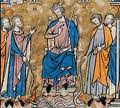Perhaps the most remarkable thing
about the Kings of Jerusalem is the fact that they were elected rather than
born.
Just one year later, however, he
was dead without an heir. The nascent kingdom was in a more precarious state
than ever, since the majority of the surviving crusaders felt they had
fulfilled their vow and returned home. Those noblemen remaining in the Holy
Land again (not without controversy) selected a successor from among
themselves, in this case, Godfrey’s brother Baldwin. Baldwin did not share his brother’s qualms
about calling himself king, and took the title of King Baldwin I. But in 1118 Baldwin
I also died without an heir of his body, and the barons of the crusader
kingdoms chose for a third time a leader from among their ranks, this time, Baldwin
of Bourcq, who thereby became Baldwin II of Jerusalem.
Three such “elections” (with
admittedly limited franchise!) set a legal precedent and the Kings of Jerusalem
were henceforth always “elected” by the High Court of Jerusalem, the later
composed of the leading lords of the realm.
This is the equivalent of the English House of Lords electing the Kings
of England!
As the products of European feudalism
with strong ties to the ruling houses of England and France, however, the members of the
High Court showed a strong bias in favor of blood relatives of the last
monarch. Nevertheless, the approval of
the High Court was considered a pre-requisite for legitimate rule. Thus every
time a king died, there was effectively an interregnum (if not outright crisis)
while factions positioned themselves and consensus was established.
Perhaps the most serious
succession crisis occurred at the critical period when Saladin had united Islam
for the first time in a hundred years and declared his intention to wage jihad against the crusader kingdoms
until he had pushed them into the sea. The king at the time, Baldwin IV,
suffered from leprosy and was dying limb by limb; he had no children. His closest male relative was his 8 year old
nephew, the son of his sister Sibylla.
To prevent Sibylla’s husband, who the dying king detested and
mistrusted, from becoming king, Baldwin IV orchestrated the coronation of his
nephew as Baldwin V during his lifetime, thereby ensuring the barons had all
sworn their oaths as vassals to the boy.
Recognizing, however, that life was fragile in the Holy Land in the 12th century, Baldwin IV also made his vassals swear to consult with the Kings of England and France and the Pope before a electing a king to succeed his nephew, if the boy did not survive into adulthood. This elaborate attempt to curtail the sovereignty of the High Court of Jerusalem failed.
Recognizing, however, that life was fragile in the Holy Land in the 12th century, Baldwin IV also made his vassals swear to consult with the Kings of England and France and the Pope before a electing a king to succeed his nephew, if the boy did not survive into adulthood. This elaborate attempt to curtail the sovereignty of the High Court of Jerusalem failed.
When Baldwin V died less than a year after his uncle, no one had time for such a lengthy process as sending to London, Paris and Rome for advice. (The English and French kings could be counted on not to agree on anything anyway, since they were at war with one another.) Instead, while the High Court was meeting in Tiberius, Princess Sibylla and her husband staged a coup: they persuaded the Patriarch to crown and anoint Sibylla queen of Jerusalem in the Church of the Holy Sepulcher. She then crowned her husband Guy de Lusignan as her consort.
Without the consent of the High
Court, however, Guy de Lusignan was a usurper.
The bulk of the barons were prepared to oppose him by crowning an
alternative candidate, namely the husband of Baldwin IV’s other sister,
Isabella. With the enemy almost literally at the gates, however, the High
Court’s choice for king, Humphrey de Toron, chose not to contest the kingship
and took an oath to Guy de Lusignan instead.
While this act made it politically impossible to oppose Guy de Lusignan,
Raymond of Tripoli was legally within his rights to refuse to swear allegiance
to Guy.
Since
Humphrey of Toron was unwilling or unable to oppose Guy, the High Court
pressured a reluctant Isabella, the last surviving child of King Amalric I, to
divorce Humphrey and take a new husband, Conrad of Montferrat. Conrad was then
recognized by the High Court as the legitimate king of Jerusalem. Since
Jerusalem was still in Saracen hands, no coronation actually took place, but
after two years Richard the Lionheart backed down and conceded that without the
consent of the High Court even an anointed king could not rule the Kingdom of
Jerusalem.







